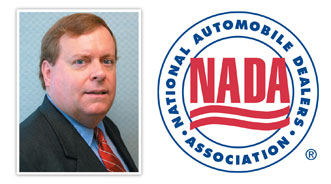NADA Economist: June New Sales to Be Constrained; Second Half Looks Brighter

By subscribing, you agree to receive communications from Auto Remarketing and our partners in accordance with our Privacy Policy. We may share your information with select partners and sponsors who may contact you about their products and services. You may unsubscribe at any time.
McLEAN, Va. –
New-vehicle sales should improve during the second half of 2011, according to Paul Taylor, chief economist of the National Automobile Dealers Association.
Why? Taylor believes the gains should begin in July as inventory levels increase and gasoline prices drop.
“Gasoline prices are currently falling, and that will allow dealers to sell a full mix of new vehicles, ranging from small cars and crossovers, to pickup trucks, despite the lack of inventory of many popular selling models resulting from the crisis in Japan,” Taylor projected.
If gasoline prices had reached $4.50 or more, Taylor insisted it would have created a shift in demand by consumers to hybrids and small economy cars — all currently in short supply.
“Sales of hybrid vehicles increase dramatically when gasoline prices rise to levels that consumers have not seen before, as they did in the summer of 2008,” Taylor surmised.
“The most popular hybrid, the Toyota Prius, is in short supply at 10 days of inventory when it should be about 60 days,” he added.
Subscribe to Auto Remarketing to stay informed and stay ahead.
By subscribing, you agree to receive communications from Auto Remarketing and our partners in accordance with our Privacy Policy. We may share your information with select partners and sponsors who may contact you about their products and services. You may unsubscribe at any time.
Taylor expects new-vehicle sales in June to be restrained somewhat by a shortage of inventory, similar to what happened in May. But he thinks the outlook for sales in July and beyond is positive as credit availability improves, and lenders look to increase their loan volume.
“Banks, credit unions and the automaker captives are all looking to finance new-vehicle purchases in the second half of the year,” Taylor noted.
EIA Offers More Background on Fuel Costs & Refinery Margins
As NADA cited dipping gas prices as a catalyst for sales, the latest update from the U.S. Energy Information Administration showed the annual average regular-grade gasoline retail price will increase from $2.78 per gallon in 2010 to $3.60 per gallon in 2011 and to $3.67 per gallon in 2012.
“The sizable jump in retail prices this year reflects not only the higher average cost of crude oil, but also an increase in U.S. refinery margins on gasoline (the difference between refinery wholesale gasoline prices and the average cost of crude oil),” EIA officials explained.
They pinpointed that the average has climbed from 34 cents per gallon in 2010 to 47 cents per gallon in 2011, still 6 to 9 cents per gallon below the record margins set in 2006 and 2007.
“Unexpected shutdowns of U.S. refining capacity in March and April with a large drop in gasoline stocks on the East Coast, along with flooding of the Mississippi river in May, contributed to the increase in margins this year,” EIA went on to note.
Furthermore, EIA expects that on-highway diesel fuel retail prices, which averaged $2.99 per gallon in 2010, will average $3.87 per gallon in 2011 and $3.95 per gallon in 2012.
Officials added projected U.S. refinery diesel fuel margins are set to increase by 21 cents per gallon, from an average 38 cents per gallon in 2010 to 59 cents per gallon in 2011 then fall to 53 cents per gallon in 2012.


